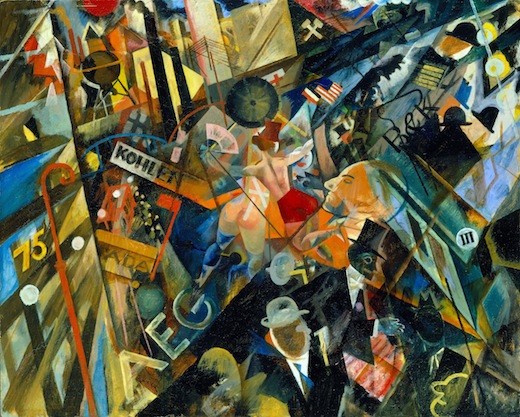You have no items in your cart. Want to get some nice things?
Go shopping
Weimar Berlin is perhaps the most seductive of the twentieth century’s hindsight illusions, a glittering shard of pop history sexiness wedged between two warmongering and wicked regimes. This is a smashingly broken metropolis of cabarets, sexologists, brazen sadomasochism and other cubbyhole perversions. It’s decadent in a tidy, parabolic way: a decline and fall story about a defeated people poisoning themselves with erotica and eugenics and having a gaudily good time doing it. Depending on your politics and tolerance for nightlife, Weimar culture is either a grease slick on the slippery slope from Wilhelmine aggression to fascist perdition or it’s a broad-minded cultural flourishing sadly betrayed.
The reality is somewhere in between. Weimar’s detonation of sleaze could have only occurred in the shambles of war, after vengeance, fizzled-out revolution, rickety republicanism and wheelbarrows of worthless marks made things in Germany go a little pear-shaped. The bedlam fed hedonism and a far-right backlash, but there was no hard line between the “deviants” and the Brownshirts. The Nazis famously ransacked Magnus Hirschfeld’s Institute for Sexual Research in 1933, but had they bothered to read his work before they doused it in gasoline they would have found a certain sympathy in his self-loathing eugenics and cautious endorsement of forced sterilization (“an interesting experiment”). Hearsay of Röhm and the SA’s unanimous homosexuality has been hyped into a bigot’s fever dream, but the homosocial Männerbund were disconcertingly fond of fascism -“misled,” Isherwood said, “by their own erotic vision of a New Sparta”. There’s no easy genealogy between high living, free loving and Nazism, but there was a lot rotten in the state of Deutschland between Versailles and Machtergreifung, a lot of fuel and freedom for its satirists.
George Grosz, whose skewering of the era’s swollen “Prostitutes, Politicians, [and] Profiteers” is now on exhibit at the Richard Nagy Gallery, was both sideline critic and uneasy invitee to this lurid end-times party. He’s a savage critic, a merciless lampooner of everything unjust, racketeering and gluttonous about Babylon on the Spree. This is the first exhibition of Grosz’s works in the UK since the Royal Academy’s 1997 retrospective The Berlin of George Grosz, and the works on display— in a private Bond Street gallery three doors down from a Prada and, unironically, down the street from Nazi outfitters Hugo Boss — are a grotesquerie of ill-gotten wealth and flagrant appetites, a parade of furs, affected monocles, disgraceful waistlines and well-fed dogs.
Grosz wasn’t just reacting to his doomsday surroundings. As the earliest pieces in the exhibit show, his fascination with the broken and the carnal predated Germany’s combustion. As early as 1912 an 18-year-old Grosz was sniffing out all the moulding eroticism the Wilhemine suburbs could offer, diving into sideshows and brothels to document the deflated sexuality of circus performers and aging prostitutes. Grosz’s whores appear as his rackeeters and industrialists do: with the same toothless pug faces and attendant dogs and the gross corpulence of unwholesome profit. Schwergewicht (Heavyweight) is a brutal— and frankly, misogynistic—depiction of aged and monstrous femininity, a recurring theme in Grosz’s work, particularly after defeat and the machinery of total war so viciously dismembered German masculinity. The prostitute dominates the scene, reclining among dogs and banana peels while a man— diminutive in hard angles and cartoonish face and bisected by the outlines of the absented room— stands aroused and useless in the back corner. When his men fight back, they target these women: ghosted, vampiric johns loom over a prostitute in a chilling Erotische Szene (Erotic Scene) and John der Frauenmörder, a recurring figure in Grosz’s work and just one entry into the grisly canon of Weimar Lustmord paintings, stalks a woman with a bloodied butcher’s knife. It’s a sadistic and pointless aggression, a fitting depiction of violence from a man who served in the Western Front’s trenches and was nearly driven mad by it.
Sometimes Grosz directs this violence inward, depicting in jittery deconstruction the anxiety that suffused this shell-shocked Berlin. Selbstmörder (Suicide) is a full colour cubist spatter of self-destruction and desperate hedonism — and at a drunken tilt that seems to pool the red watercolour of blood in the corners. Like many of Grosz’s street scenes it’s splintered, cleaved into jagged parts in a way that echoes Cubism or Futurism but is more appropriately described as Dadaist. This is a senseless splicing, a deconstruction not to represent the seductive forward motion of modernity or the anatomized operations of art and perspective — just the unnavigable absurdity of his Berlin. When Grosz shows legs in blurred triplicate, as in Erotische Szene, it’s to show the languid, corrupt pleasure of a whore — not, like Giacomo Balla, the whirling Dynamism of a Dog on a Leash — and when he dissects a body into parts it’s to show its impotence, amputation and madness.
For all his ruthless satire, Grosz never pretended to hold the moral high ground. He was an active voyeur in this commoditised underworld, drunk off the vicarious wreckage and happily in collusion with the city’s sleaze profiteers and fakers. When he plumbed the “dens of pseudo-vice”, Isherwood found boys in drag and monocled girls “play-acting the high jinks of Sodom and Gomorrah, horrifying the onlookers and reassuring them that Berlin was still the most decadent city in Europe”. Everything charmingly sordid and countercultural in Berlin was partially staged and always for sale, and Grosz gleefully bought into it. His art is a trainspotting of debauchery. He himself was self-consciously decadent, known to rub elbows with the self-promoters at the Café des Westens, styled as an American gangster or cowboy and decked out in nearly bourgeois amounts of rouge. Grosz and the others braggers of “Café Megalomania” were hoping to attract the attention of the city’s journalists and cultural kingmakers with ostentatious displays of weirdness — quite a lot like Hackney hipsters shearing their hair for stares and selfies and angling for a style blog shot in ill-fitting pants; quite a lot like Isherwood’s self-aware degenerates.
Later Grosz would recount that he was “everybody I drew, the rich man favored by fate, stuffing himself and guzzling champagne, as much as the one who stood outside in the pouring rain holding out his hand”. Grosz’s art, magnetised by the perverse, was enabled by this sordid sympathy: his own indulgence of himself, his voyeuristic impulses and caricaturist’s nastiness. Maybe it was that guilty complicity that made him such a ferocious critic. Regardless, when he rubbernecks and viciously exaggerates, he gives us the Weimar of our most fevered imaginations: violent, voluptuous, and blundering toward inferno.
The free exhibition George Grosz’s Berlin: Prostitutes, Politicians, Profiteers is on at Richard Nagy Gallery until November 2nd. For more on Weimar Berlin, listen to Litro‘s excellent podcast on the topic from February this year.





